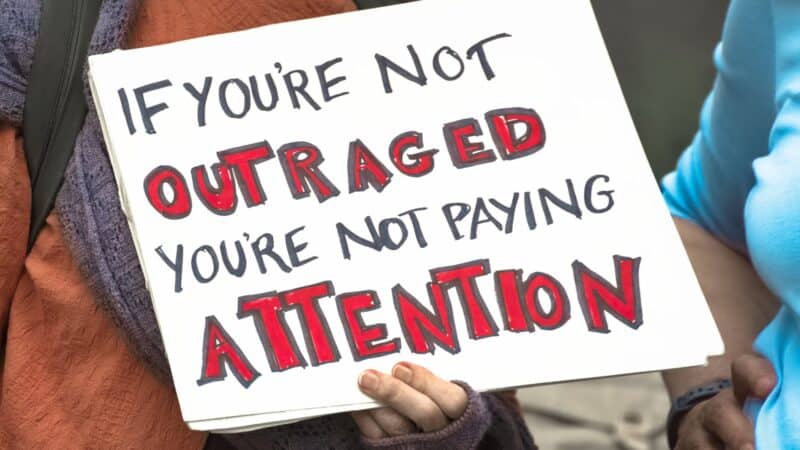
Welcome to the age of outrage, when even the most innocuous ad risks becoming a culture war casus belli. Tonight’s presidential debate will draw attention to the national political campaigns for another highly divisive election — which will make brands’ already tough situation even worse. By now marketers may feel like they’re trying to ride a pogo stick across a minefield.
“This is a very sensitive time for brands because it can be very polarizing no matter what position you stand for,” Adam Ortman, founder and president of the Kinetic319 agency, told MarTech.
So what’s to be done? The answers from both veteran marketers and the latest polling may surprise you.
“We’re moving away from an era of creativity to an era of safety,” Jeff Levick, CEO of We Are Rosie, a talent marketplace for advertising and marketing, told MarTech. “I don’t believe that’s what consumers are looking for. I think that’s what a niche number of consumers are looking for, but unfortunately, their voice is very loud and brands have become very afraid.”
In the past two years, there’s been a significant drop in Americans who want to hear from brands about current events. In 2022 48% of U.S. consumers said businesses should speak up, according to a Gallup poll. Last year it was down to 41%.
Some things are more political than others
Not all current events are created equal though. Gallup found Americans were most supportive of companies discussing climate change (55%) and mental health (52%). They were overwhelmingly opposed to them taking public stands on religion (15%), political candidates (19%) and abortion (26%).
More than half (54%) of people in the U.S. buy, choose or avoid brands because of politics, according to a the 2024 Edelman Trust Barometer, up from 52% last year.
And a huge number of things are considered political. Here’s Edelman’s list of the percent of U.S. consumers who found these brand actions to be political:
- Taking a stand on issues (43%).
- Using social media that hosts extremists (43%).
- Hiring influencers with pol. Opinions (35%).
- Encouraging voting (30%).
- Advertising near political news (29%).
- Working on regulations (27%).
- Recruiting diverse employees (22%).
- Reducing climate impacts (20%).
Say nothing?
Given all this, it makes sense that some companies choose to go silent.
“Brand safety is incredibly important,” said Ortman. ”We have clients that feel that marketing during a certain unfavorable climate is too risky. So they may remove themselves from certain marketing channels, from certain marketing tactics, or they might just turn off marketing altogether for a certain period of time.”
This happened after 9/11, during the mortgage meltdown and recession around 2008 and most recently in 2020 at the start of the pandemic. However, those were all things that Americans mostly agreed on. Staying silent on very divisive issues can be costly too.
The Edelman survey of people in 15 nations found that 51% of the 15,000 respondents assume the worst if a company says nothing on a major topic. That increased to 56% in the key 18 to 44 demographic.
Of course, going silent or quieter is no guarantee of safety. The smallest thing may be seized on as a point of outrage. Case in point: Bud Light.
In February 2023, the beer company asked a dozen notables to remix its latest advertisement. One of them was Dylan Mulvaney, an actor and comedian who is a transgender woman. Her remix was released along with the others and few people outside of her fanbase noticed. Six weeks later Mulvaney did an Instagram post that briefly showed a personalized Bud Light can the company had given to her. This time a lot of people noticed.
Under attack

Right-wing commentators, politicians and celebrities — including Caitlyn Jenner, also a transgender woman — flocked to the issue like moths to a light-bulb. Mulvaney, the brand’s head of marketing and at least one Bud Light brewery were the targets of violent threats. In addition to the threats, there was a very successful boycott.
Two weeks after Mulvaney’s post, Bud Light’s sales were down 17%. Within a month Bud Light was no longer the best-selling beer in America, a position it had held for two decades. By the end of that quarter, Anheuser-Busch reported a 10.5% decline in US revenue. At the end of August of last year, four months after the initial post, sales were down 27% year on year. While sales began improving in April, they remain well below pre-boycott levels.
How could they have avoided this?
In marketing, there’s no such thing as knowing your customer too well. A big question is what, if any, market research did Budweiser do on this topic?
Dig deeper: Pride Month is about authenticity, not ‘rainbow washing’
“For very mature brands, like Budweiser, I would say do the overkill level of research ahead of time,” said Ortman. “I don’t know what research they did ahead of that time. Who knows? That might have just been a marketing decision of saying, this is a demographic that we would like to reach into and let’s incorporate it into our marketing. “
The LGBTQ+ community is a focal point for people across the political spectrum. Transgender people, who are less than 1% of the U.S. population, come in for an outsized portion of attention. Any brand — B2C or B2B — that doesn’t research customer attitudes on the issue is taking a substantial risk.
Stick to your guns
As the crisis unfolded, Anheuser-Busch CEO Brendan Whitworth released a statement on the company’s website about the “importance of accountability” and taking responsibility “for ensuring every consumer feels proud.” This was the first of several tepid statements from the company which managed the neat trick of irritating both critics and supporters.
As former Texas Agriculture Commissioner Jim Hightower once said, “There’s nothing in the middle of the road but a yellow stripe and dead armadillos.” The fact is consumers like companies that stick to their guns. The Edelman survey found 65% of U.S. consumers would lose trust in a brand that surrenders to politically motivated attacks.
In 2016, San Francisco 49ers QB and Nike advertising icon Colin Kaepernick decided to kneel during the national anthem to protest police violence against Black people. This caused a very partisan outrage and cost Kaepernick his football career. Two years later, when Kaepernick’s contract with Nike was about to expire, the company resigned him and made him a focal point of its “Dream Crazy” campaign, which also featured other athletes active in social issues, such as LeBron James, Serena Williams and the U.S. women’s soccer team.
Being silent would have been a much bigger risk for Nike. As Alex Ortman said, “If you have a loud voice and you don’t speak on something as a brand, you better be prepared for people to ask you what your opinion is.”
On the other hand, said Ortman, “If you want to speak on an issue and are not known for taking a stance, my main question to that business leader would be why now? And you better have a good reason. And that reason should materially impact the business in a positive manner.”
Nike’s stock price rose 5% following the campaign launch.
To thine own self be true
The sports apparel behemoth is one of many brands — including Ben & Jerry’s, Patagonia, REI and TOMS — to succeed by loudly embracing values far from the middle of the road.
Doing this requires speaking with authenticity.
“The safe position is authenticity,” said Levick. “You’re in a divisive environment. You’re never going to appeal to everyone. Brands that understand that know that while this person isn’t going to be happy with us, it’s okay because these other communities will be with us, and that’s how we will continue to grow our brands. And at the end of the day, it’s about growing revenue.”
Authenticity requires a deep understanding of how your brand is perceived. Some executives make the mistake of thinking they already know that. Ortman attributes this to what is known as The Projection Fallacy.
That is when you take the opinions of a small group and project them onto a much larger one. In other words, you assume everyone agrees with you.
“Just because a brand owner, CEO, founder, whatever, feels one way about a specific topic, they should be careful about projecting that same sentiment onto their customers or use it for their brand positioning,” said Ortman.
He recommends putting together a team of outside experts to look at the brand and how it’s perceived. “They usually provide a good external perspective,” he said. “And most of the time, clients are thinking to themselves, ‘Uh-oh, I didn’t even think about that.’”
Don’t try to split the difference
Budweiser’s attempt to appease both sides was so ham-handed its failure was obvious to everyone. Other companies have managed to do this in a way that has put out the immediate fire but with a long-term cost.
Target is one of many retailers attacked for supporting Pride month and selling Pride-themed merchandise. It is also one of many that have pulled the merchandise from its stores but continued to sell it online.
“Target was just such a great sponsor of Pride and has a huge LGBTQ+ community behind them,” said one agency marketer who asked to remain anonymous. “And then all of a sudden, they’re like, ‘We’re no longer celebrating this in the store. But it’s okay if we do it online.’ What that’s saying is we’ll do it in a quiet space, but we’re not going to do it in a public space.”
Before the internet brands could run marketing campaigns for particular audiences in channels like magazines that were seldom seen outside of the targeted community. Those days are long. Today, you have to assume that not only will everyone know all the groups you are marketing to, but some are almost certainly not going to like it.
The post How to market in the age of outrage appeared first on MarTech.










